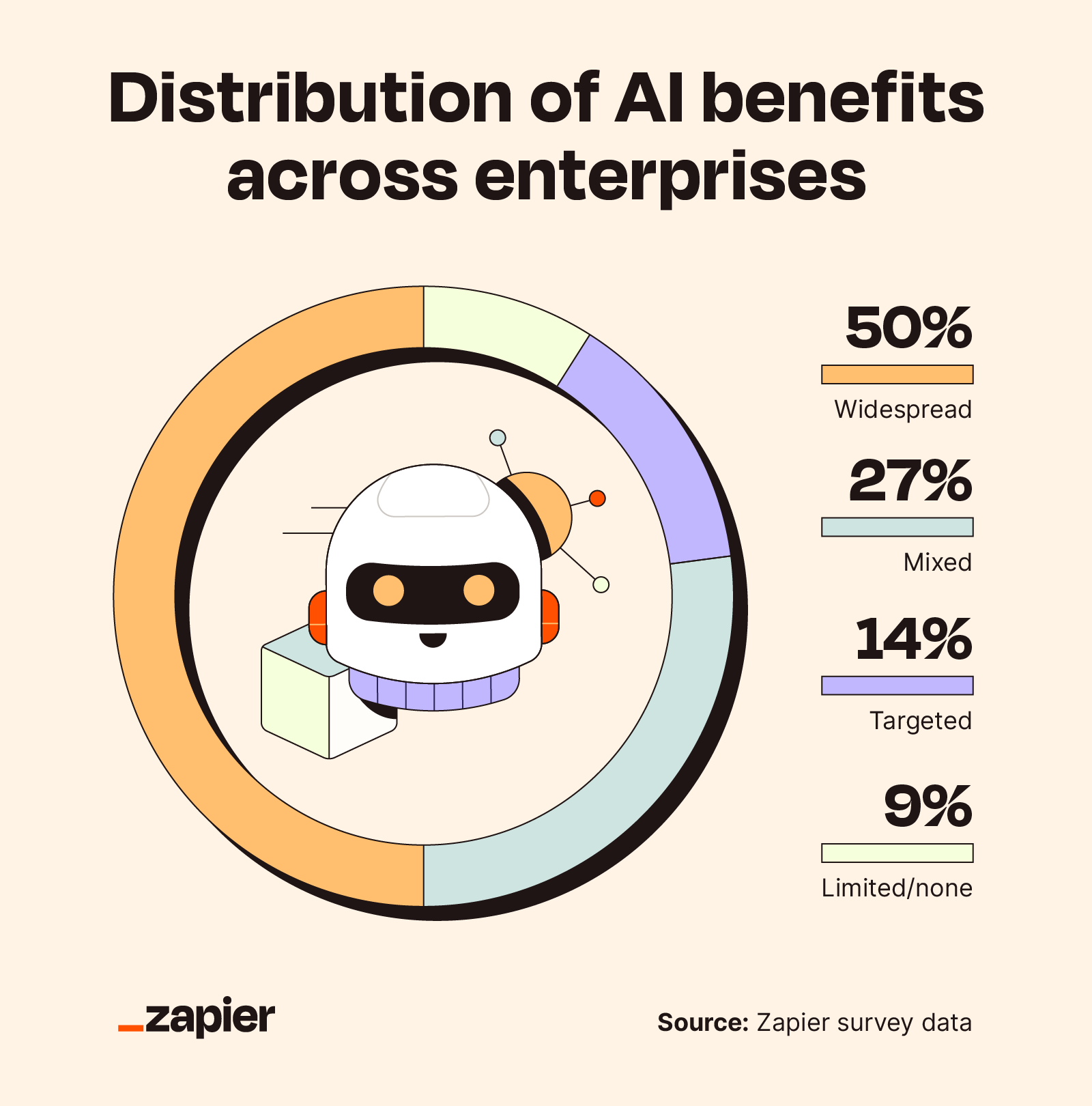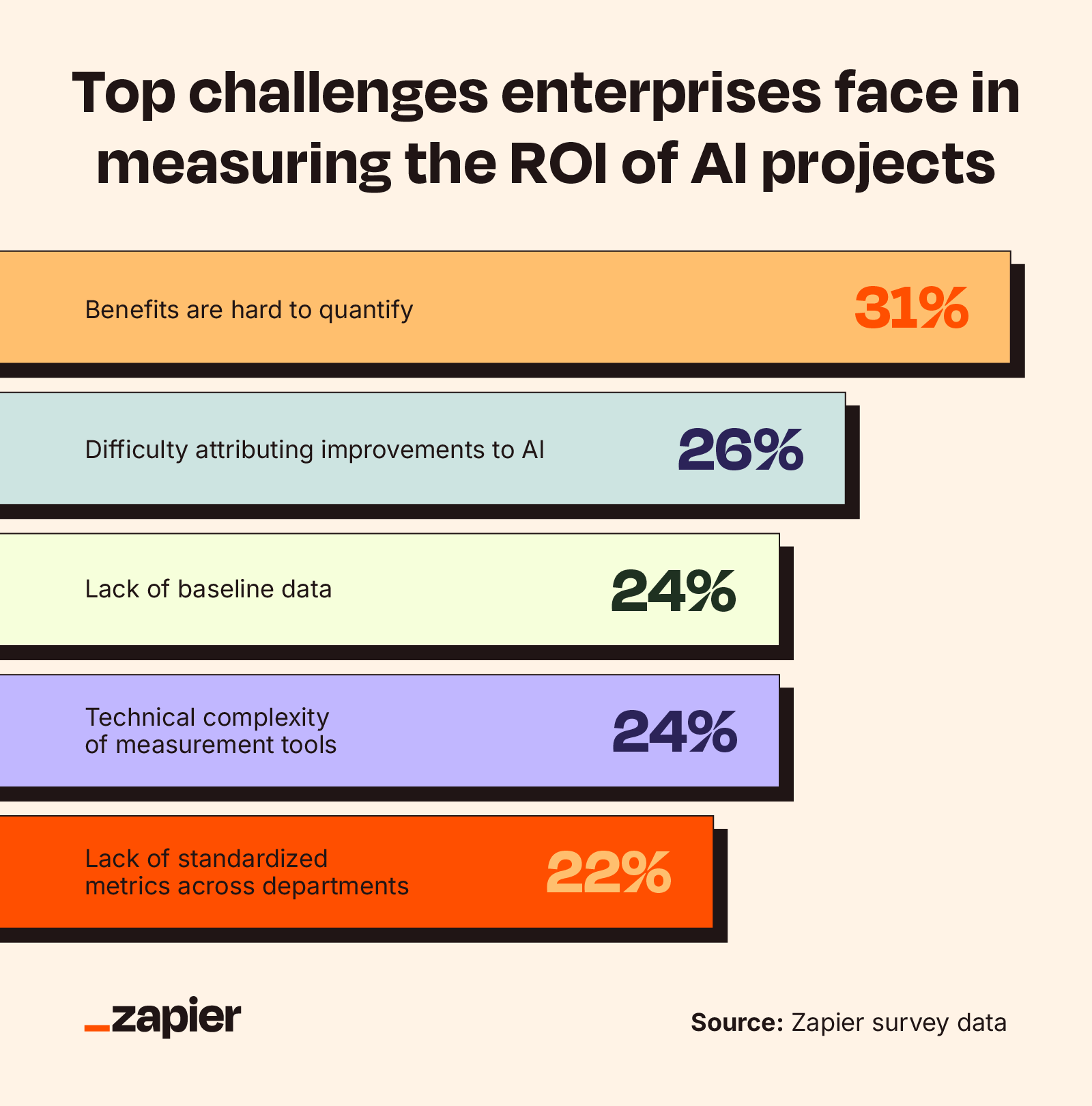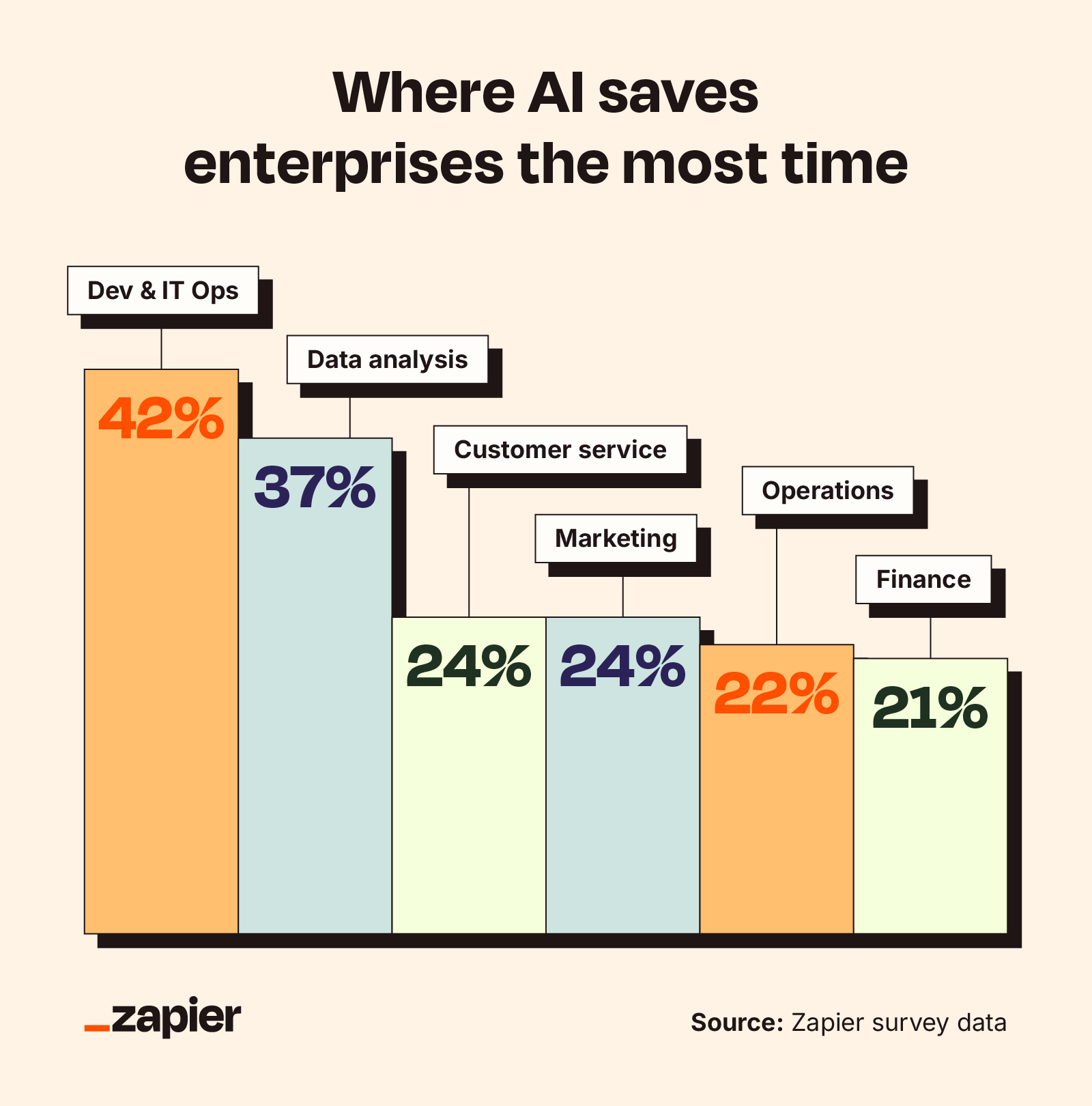If you’d asked me to guess how many enterprises are using AI these days, I’d have confidently blurted out something in the respectable 70%-80% range, patted myself on the back, and moved on with my life. Well, joke’s on me (again, as usual), because the real number is 97%.
However, just because everybody’s using AI doesn’t mean it’s actually doing anything useful. Only half of enterprise leaders say AI’s benefits are widespread across their organization. It’s like having a gym membership that you use exclusively to take mirror selfies in the locker room. Sure, you’re technically “at the gym,” but are you actually getting swole?
We surveyed more than 500 enterprise leaders across industries to reveal the gap between AI adoption and AI impact. While nearly every company has jumped on the AI train, most are still figuring out how to make it work for everyone, not just a lucky few departments.
Table of contents:
Execs say AI benefits are widespread—other decision-makers don’t
There’s an interesting disconnect happening in the C-suite versus the trenches. A whopping 63% of executives believe AI benefits are widespread across their organization. Meanwhile, only 42% of directors and middle managers agree. This is what we in the biz call a math problem.
But wait, there’s nuance! While exactly half of all leaders overall describe AI’s benefits as “widespread” across most or all teams, the rest paint a patchier landscape: 27% report a “mixed” scenario where some teams win while others don’t, 14% say benefits stay concentrated in just a few areas, and only 9% see very limited or no benefits. Basically, this means AI is working—just not as evenly as the corner office thinks.
To be fair, the maturity of AI implementation plays a big role here. Businesses that have fully embedded AI into their operations are more than twice as likely to see widespread benefits compared to those just running a few pilot projects (76% vs. 36%). It’s clear that near-universal adoption (97% have AI somewhere) doesn’t automatically translate to universal impact.

If leadership thinks AI is more widespread than it actually is, Zapier’s no-code approach to AI automation can help. It lets all business teams, including non-technical users, build and orchestrate workflows without sacrificing security and governance. It’s an easy way to bring the benefits of AI to your entire company.
73% of companies have a formal AI ROI process, yet 91% struggle to measure AI’s true value
A vast majority of companies (73%) have formal processes to track AI returns, but almost everyone struggles to actually measure them effectively. Only 9% say they measure AI ROI with “no challenges,” meaning 91% are wrestling with proving AI’s worth.
The organizations without ROI tracking are essentially playing a high-stakes game of “Trust Me, Bro”—17% of them report widespread benefits compared to 62% of organizations with formal ROI processes.
Companies that don’t measure tend to focus narrowly on obvious wins—39% cite “time savings” as their top benefit. Meanwhile, the adults in the room with ROI tracking see diverse payoffs: time savings (20%), customer experience improvements (15%), and innovation opportunities (15%).
The measurement gap gets more dramatic when you look at revenue. Companies measuring ROI are 10 times more likely to say AI brings in new revenue (10% vs. a tragic 1%). That’s not a coincidence—it’s evidence that you can’t optimize what you don’t measure.
Zooming out, industry patterns reveal another layer of this challenge. Tech and software companies lead ROI tracking at 87%, while healthcare (44%), education (47%), and media (38%) lag dramatically. Interestingly, 88% of C-suite respondents report having formal AI ROI processes compared to only 64% of lower-level leaders. Either the executives are living in a fantasy world, or middle management isn’t being CC’d on those ROI spreadsheets.
The measurement challenges themselves reveal why this is so hard. While fewer than 1 in 10 say they measure AI ROI without any challenges, the rest of us mortals struggle with headaches like long-term benefits that are hard to quantify immediately (31%), benefits that are mostly qualitative (28%), attribution challenges (26%), lack of baseline data (24%), and technical complexity (24%).

Zapier brings together all your AI data in one place so you can actually measure ROI. By adding AI directly into the tools and workflows your team already uses, Zapier helps move AI from one-off tests to coordinated processes that improve work, measurably, across the business.
Time savings is the single biggest AI payoff for enterprises
Here’s something that won’t surprise anyone who’s ever worked a day in corporate America: the number one thing enterprises love about AI is that it saves time. A full 25% cite time savings as their top measured AI benefit—more than three times higher than cost savings at just 8%.
After time savings, the benefit ranking reads like a corporate wish list:
-
Improved customer experience (13%)
-
Innovation opportunities (12%)
-
Error reduction (9%)
-
Improved employee experience/reduced burnout (9%)
-
Cost savings (8%)
-
New revenue (7%)
Where is AI saving the most time? Technical teams are seeing the biggest wins by far, with software development and IT Operations leading the way (42%). Data analysis isn’t far behind at 37%. After that, there’s a cluster of areas seeing solid gains, including customer service response times (24%), content creation and marketing automation (24%), operations and supply chain coordination (22%), and finance and accounting workflows (21%).

As enterprises mature in their AI journey, their priorities shift. Fully embedded organizations report customer experience (16%) improvements narrowly edging out productivity (15%). Yes, that’s right—AI is now officially better at being nice to customers than we are. Humanity, you’ve had a good run. As for big-ticket dreams, revenue growth and risk reduction, which barely register in pilot programs, jump to 10% each at full maturity.
What’s remarkable is how few organizations are coming up empty-handed. Less than 1% of respondents said they have “no measurable benefits yet” from AI. Nearly everyone is finding something valuable, even if it’s just getting their reports done faster.
Zapier’s AI orchestration platform lets you delegate work to AI agents that can take action in all your apps—saving time, reducing errors, lowering costs, and unlocking new strategic opportunities. And when you want a little more human control, Zapier Workflows are there to help you connect your entire tech stack in a deterministic fashion.
HR is outpacing Marketing and Sales in AI adoption and benefits
If you’d told me two years ago that HR would be a bigger AI adopter than Marketing and Sales, I’d have suggested you lay off the experimental kombucha and maybe sit in a quiet room for a bit. But the data has spoken: HR ranks as a top AI-using team in 26% of organizations, ahead of Marketing (23%) and Sales (13%).
Naturally, IT still dominates, with 60% saying it’s their top AI department for usage and 54% saying it gets the greatest benefits. However, 28% of respondents say IT benefits least from AI despite being the top implementer. It’s a classic case of the cobbler’s children having no shoes—IT teams are so busy rolling out AI for everyone else that they haven’t optimized their own workflows.
Legal teams are severely lagging—only 6% see major AI benefits in legal functions, and 1 in 5 (21%) say legal benefits the least from AI. This tracks because legal departments operate on a level of risk aversion that makes my anxiety look casual. Frontline field staff also struggle, with 20% saying these workers benefit least from AI initiatives.
There’s an interesting psychological pattern in how leaders view their own departments. When you ask HR leaders specifically, 73% say HR is a top AI user (despite the 26% overall average). Similarly, 87% of IT leaders claim IT is the top user (versus 60% overall). Everyone thinks their team is leading the charge, which probably means enthusiasm for AI is more widespread than any single metric captures.
91% of enterprises report cross-org AI tool challenges
Here’s where the AI success story hits a speed bump: 91% of enterprises face friction from AI tool sprawl. Only 9% report “no significant challenges” when it comes to managing AI tools across departments, and these people are either pathological liars or have achieved a level of organizational zen that should be studied by business schools.
Security concerns lead the problem parade at 30%—and it’s easy to see why. When different teams adopt different AI platforms, data starts flowing through various systems without centralized oversight. IT security teams are right to be nervous about the proliferation of AI tools that may not meet enterprise security standards.
Training employees on multiple AI interfaces plagues 29% of organizations. Imagine being a marketing manager who has to learn one AI tool for content creation, another for campaign optimization, and a third for customer analysis. The cognitive overhead alone is exhausting, let alone the time cost of switching between systems.
Other pain points include teams using completely different AI solutions (27%), a lack of centralized AI oversight (23%), and tools that don’t integrate well together (20%). These are all well-known enterprise software problems, but they’re happening at warp speed thanks to AI.
The hidden costs are real, too. One quarter of companies report high costs from maintaining separate AI tools. When every department picks its own AI solution, organizations end up paying for redundant capabilities and missing out on volume discounts.
Zapier, the most connected AI orchestration platform, can help you get over the AI integration gap. With more than 8,000 integrations across the tools you already use, Zapier can securely bring AI to all your workflows and set you up for a future where enterprise-wide AI is a must instead of a “nice to have.”
Scale AI benefits across your enterprise with Zapier
Organizations with integrated, measured AI strategies see broader benefits than those with fragmented nightmares of disconnected tools. While 97% of enterprises have adopted AI somewhere, only half are seeing widespread benefits because of integration challenges, measurement gaps, and tool sprawl.
This is exactly where Zapier can transform your AI strategy. Instead of managing dozens of disconnected AI tools, Zapier lets you connect your AI investments into unified workflows that span departments. And business teams can securely ship AI workflows themselves, so value isn’t stuck in a bottleneck.
Whether you’re trying to share AI-generated insights across teams, standardize data flows between AI tools, or measure ROI consistently, Zapier provides the AI orchestration backbone that turns isolated AI experiments into organization-wide advantages.
Methodology
The survey was conducted by Centiment for Zapier between September 14 and September 26, 2025. The results are based on 546 completed surveys. In order to qualify, respondents were screened to be U.S. C-Suite Executives, Presidents, Owners, or Partners at companies with 1000+ employees. Data is unweighted, and the margin of error is approximately +/-4% for the overall sample with a 95% confidence level.
Related reading: